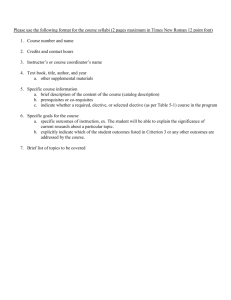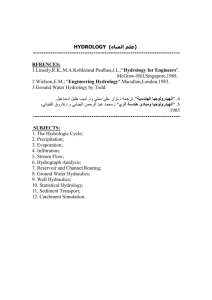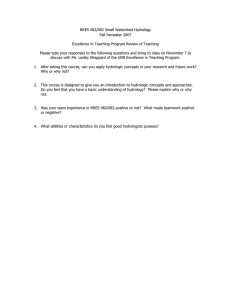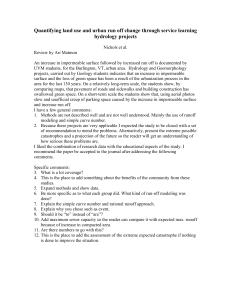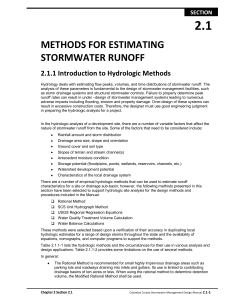CE460 - Department of Civil and Environmental Engineering
advertisement
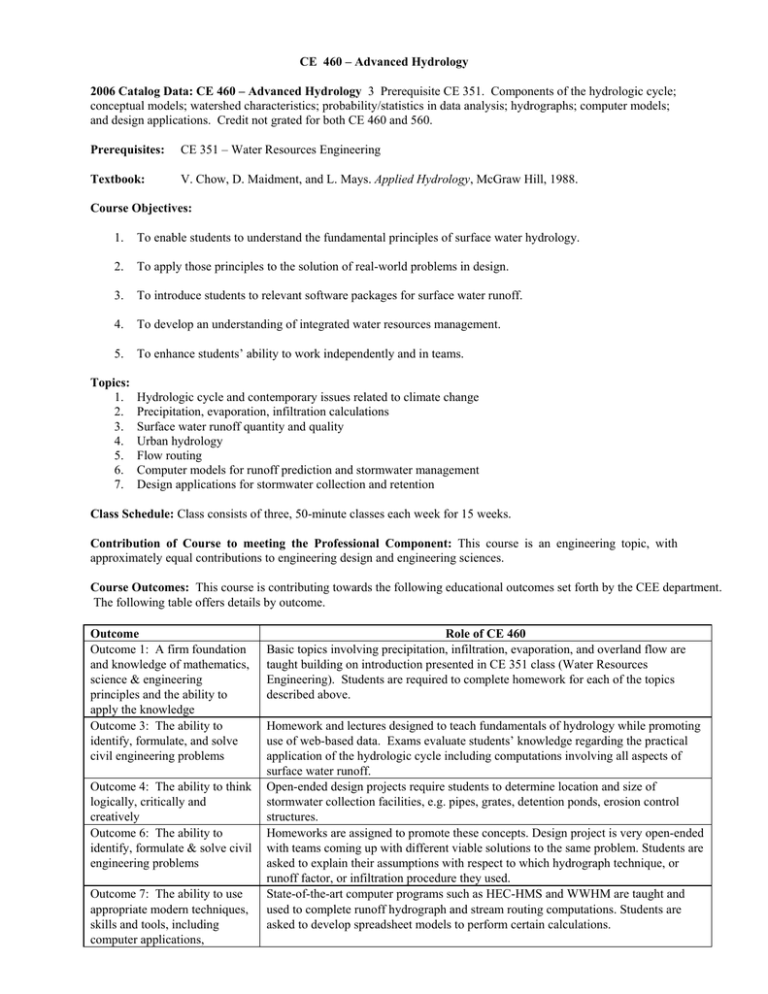
CE 460 – Advanced Hydrology 2006 Catalog Data: CE 460 – Advanced Hydrology 3 Prerequisite CE 351. Components of the hydrologic cycle; conceptual models; watershed characteristics; probability/statistics in data analysis; hydrographs; computer models; and design applications. Credit not grated for both CE 460 and 560. Prerequisites: CE 351 – Water Resources Engineering Textbook: V. Chow, D. Maidment, and L. Mays. Applied Hydrology, McGraw Hill, 1988. Course Objectives: 1. To enable students to understand the fundamental principles of surface water hydrology. 2. To apply those principles to the solution of real-world problems in design. 3. To introduce students to relevant software packages for surface water runoff. 4. To develop an understanding of integrated water resources management. 5. To enhance students’ ability to work independently and in teams. Topics: 1. 2. 3. 4. 5. 6. 7. Hydrologic cycle and contemporary issues related to climate change Precipitation, evaporation, infiltration calculations Surface water runoff quantity and quality Urban hydrology Flow routing Computer models for runoff prediction and stormwater management Design applications for stormwater collection and retention Class Schedule: Class consists of three, 50-minute classes each week for 15 weeks. Contribution of Course to meeting the Professional Component: This course is an engineering topic, with approximately equal contributions to engineering design and engineering sciences. Course Outcomes: This course is contributing towards the following educational outcomes set forth by the CEE department. The following table offers details by outcome. Outcome Outcome 1: A firm foundation and knowledge of mathematics, science & engineering principles and the ability to apply the knowledge Outcome 3: The ability to identify, formulate, and solve civil engineering problems Outcome 4: The ability to think logically, critically and creatively Outcome 6: The ability to identify, formulate & solve civil engineering problems Outcome 7: The ability to use appropriate modern techniques, skills and tools, including computer applications, Role of CE 460 Basic topics involving precipitation, infiltration, evaporation, and overland flow are taught building on introduction presented in CE 351 class (Water Resources Engineering). Students are required to complete homework for each of the topics described above. Homework and lectures designed to teach fundamentals of hydrology while promoting use of web-based data. Exams evaluate students’ knowledge regarding the practical application of the hydrologic cycle including computations involving all aspects of surface water runoff. Open-ended design projects require students to determine location and size of stormwater collection facilities, e.g. pipes, grates, detention ponds, erosion control structures. Homeworks are assigned to promote these concepts. Design project is very open-ended with teams coming up with different viable solutions to the same problem. Students are asked to explain their assumptions with respect to which hydrograph technique, or runoff factor, or infiltration procedure they used. State-of-the-art computer programs such as HEC-HMS and WWHM are taught and used to complete runoff hydrograph and stream routing computations. Students are asked to develop spreadsheet models to perform certain calculations. necessary for engineering practice Outcome 8: An understanding of professional ethics & integrity and an engineer’s responsibilities to the profession and society Outcome 9: Ability to communicate effectively in written, oral, and graphical forms Outcome 10: Awareness and understanding of the impact of engineering on global & societal issues Outcome 11: A knowledge of contemporary issues Outcome 12: Recognition of the importance of life-long learning and the benefits of being active in professional societies such as ASCE Discussion and assignments related to examining the impact of coefficient selection in the sizing of bridges, canals, pipes and the problems associated with failure. The roles of contractor, developer, regulator, and engineer are discussed. A couple of assignments required written evaluation of reports. Group project requires a team of 3 to 4 students to work together to solve a design and turn in written report and give oral presentation. Numerous homeworks required data to be plotted. Principle applications of hydrologic cycle applied to land development and flood control. Urban stormwater design discusses trade-offs of cost versus benefits both in terms of economic and environmental. Many stormwater problems are presented in context of protecting aquatic species as well as simple flood control. Examples using King County (Seattle) and Portland areas tied to salmon protection and stream restoration. Global climate change impacts in the Pacific Northwest are discussed. References are made to professional short courses available that go beyond the amount of material that can be presented in a class are given. The need to keep professional registration current once obtained is also discussed. Prepared by: Michael Barber, June 2006
